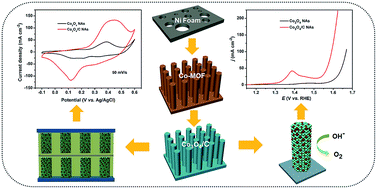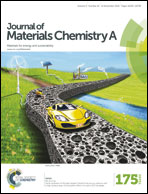Hierarchically porous Co3O4/C nanowire arrays derived from a metal–organic framework for high performance supercapacitors and the oxygen evolution reaction†
Abstract
Transition metal oxides with hierarchically porous structures supported by conductive substrates have been considered as promising electrodes for electrochemical energy storage and catalysis. Herein we configure porous Co3O4/C nanowire arrays (NAs) by thermally annealing a Co-based metal–organic framework (Co-MOF) in Ar and air, respectively. The hybrid Co3O4/C NAs demonstrate a high specific capacitance of 1.32 F cm−2 at a current density of 1 mA cm−2, which is much superior to that of bare Co3O4 NAs. A highly stable symmetric supercapacitor based on Co3O4/C exhibits an excellent durability with only 21.7% capacitance decay after 5000 cycles. Besides electrochemical energy storage, the Co3O4/C hybrids demonstrate an outstanding electrochemical catalysis ability for the oxygen evolution reaction, identified by the high current density of 30 mA cm−2 at low overpotential (η30 = 318 mV) and a small Tafel slope (81 mV dec−1). The electrical conductivity of the interconnected C infrastructures and ion diffusion within the hierarchical pores are intrinsic causes to promote the pseudo-capacitive performance and enhance catalytic activity. The synthesis strategy reported here opens an avenue to design high performance electrodes for energy storage and electrochemical catalysis.


 Please wait while we load your content...
Please wait while we load your content...